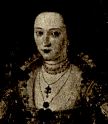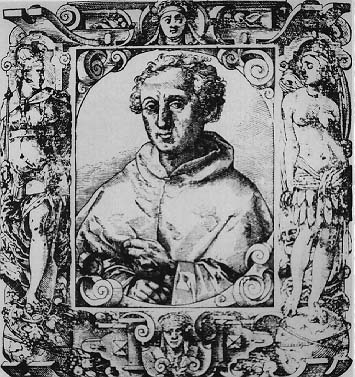Lecture IV-- Women and the New WorldWeek 4. The fourth class session will explore the developments of the late Fifteenth, Sixteenth, and Seventeenth Centuries that opened up the world of publication possibilities for women writers.
Our unknown author of the evening: Lady Mary Wroth
LADY Mary Wroth, "daughter to the right noble Robert, Earl of Leicester, and
niece to the ever famous and renowned Sir Philip Sidney...and to the most excellent
Lady Mary, Countess of Pembroke"{1}, was born in 1586 or 1587.{2} She was
often in the home of her namesake, Mary Sidney Herbert, where she had access to
classical and humanist literature and the unpublished works of various
Sidneys,
including probably the Old Arcadia. Throughout much of young Mary's childhood,
Robert Sidney was in charge of the English garrison at Flushing, in the Netherlands,
and was able to see the family only at infrequent intervals. Upon the death of Queen
Elizabeth, he began a rapid rise at Court, being created Baron Sidney of Penshurst
by King James. Thereafter the family was frequently seen at Court, and Mary, now a
young woman, became an active participant in Court doings about 1604. She
participated in Court Masques before Queen Anne, one of which was Ben Jonson's
The Masque of Blackness, which was designed by Inigo Jones. Jonson took an
interest in Mary Sidney's writing, as did a number of other poets of the time,
including George Chapman. Jonson dedicated The Alchemist to Mary, and wrote of
her that her sonnets made him "a better lover and a much better Poet" {3}. "When night's black mantle could most darkness prove" Most experts agree that broad historical changes play themselves out in surprising ways. The invention of the printing press, the discovery of the new world, the rise of a mercantile class, and the ideas, even, of the French Revolution all had significant consequences for the progress of the world, of mankind, of democracy, and of freedom. One unanticipated, and perhaps unwelcome in many quarters, outgrowth of these events was the emergence of the voice of women. Far before any suffragette could undertake to demand the vote, women needed to create a way to define themselves, establish a public identity. Mary Wollstonecraft (Mary Shelley's mother) was one of the powerful voices in this effort, but there were many more, now ignored for the most part, who found a new identity in the shifting, pre-modern world.
We analyzed the conditions and patterns that have led to the creation and preservation of writing by women. We will continue to talk about these patterns as we begin to explore the writers whose books we are reading. I have also added to the Graphics Images Chart and the Text Chart, which you can continue to use in your ongoing research and class project. Lecture for Fourth Class: Women and the New World
Extracts from the Journal of Christopher Columbus *Columbus was the first European to see the Orinoco River, by the way No matter how you wish to conduct the analysis, nearly all historians have remarked on the enormous changes that occurred in Europe sometime after 1400 and, probably, continuing to the present. But the period of 1450-1650 ranks as an especially important period for sweeping changes that challenged the small, tidy, manageable world of Medieval Europe. I have chosen to foreground the discovery of the New World in this lecture for a few reasons that have to do with our course of study. First, we are beginning to discuss Aphra Behn. Her novel, Oroonoko depicts not only the natives of South America, but makes a clear distinction between them and the hero and heroine, who are captives from Africa. In this way, she makes one of the earliest statements about the nature of the peoples of the Old World and the New World; the discovery of the American Continent is important to our study of the proto-novel. Second, the New World was saturated, in quite unlikely ways, with sexuality - in everything from the confounding of the idea of "virgin" land with the "virgin" woman, to the rumors of fantastically beautiful women in various conditions of undress; adventure, freedom, and wealth were all associated with the romance of travel to this marvelous place. Finally, the influx of new wealth to Europe itself changed society and forced the aristocracy of church and land to give ground to the new mercantile classes. Once the door was open, even a crack, the whole edifice, so carefully constructed during the Middle Ages, came tumbling down, in place after place....
As we saw in our survey of life patterns that we could identify in women writers, in the Western World a great change began to take place around the 15th or 16th Century. Suddenly the hierarchies and rules of Medieval Society began to be challenged. Aphra Behn was writing during this sea-change, so our lecture tonight is a way of introducing the marvelous and trend-breaking Oroonoko. Several important events led to the changes that we think of as the Renaissance - but there were deeper movements afoot, as well. The Discovery of the New World The Discovery of the New World: When Columbus went ashore that fateful day of October 12, 1492, according to his own accounts, he unfurled a flag and pronounced all the territory that he had found and would find the property of the Spanish King and Queen. He justified this possession of territory that he knew was already inhabited by noting: "and no opposition was offered to me." There was high irony in this act, and not a little naiveté, perhaps. But it is instructive that no opposition could be offered to him because the Native Inhabitants of the land had not the vaguest idea of what he had said. He offered them gifts, which they assumed were free, not in the least bit understanding that Columbus intended a bargain of sorts, beads for all the land, its wealth, and its people.
In general, the discovery of the New World had these long-term affects:
but let us look at things another way, examining the economic impact of this Marvelous Possession: (this information is from The Great Frontier by Walter Prescott Webb) prior to 1500 the Metropolis [Western Europe] comprised all the known world save Asia, which was only vaguely known. Its area was about 3,750,000 square miles and its population id estimated at 100,000,000 people. It was a static society with well-defined classes. The population pressed hard on the means of subsistence. There was not much food, and practically no means of escape for those people living in a closed world. The idea of progress had not been born. Heaven alone, which could be reached through the portals of death, offered the only hope to the masses.
Then came the miracle that was to change everything -
rich gifts of land, gold, silver, food, clothing - undreamed-of treasure. Three new continents and a large part of a fourth. what Europe acquired was an empty land five or six times the size of Europe. All of it rich with free resources. It started a boom like the world had never known before, and possibly never will again. Although the winners in the wars for possession of the new land (which began in 1689 and ran roughly through 1783) - England, France, and Spain - had lost title of these possessions by 1820, the boom continued, and all of Europe continued to grow rich from the exploitation of the new land. An unprecedented boom of 400 years. It destroyed the institutions of the Medieval World and created a set of new ones - political, social, and spiritual - that were founded on, and shaped by, the BIG BOOM!
Population. Land. Capital. One of the things that the New World did was to change the relationships between man (and therefore woman) and almost every aspect of the economic world. With 100,000,000 people and 3,750,000 square miles, in 1500 we have an average density of 26.7 people per square mile, about 24 acres, good or bad, for each individual. The scarcity of land was reflected in inheritance laws, in late marriage, and in enforced celibacy on those who lacked inheritance or dowry. Europe had a saturation of people and an oversupply of labor. Suddenly, added into the mix was 20,000,000 square miles, almost unpopulated, by European standards. Suddenly, the "potential" population density was reduced to less than 5 people per square mile - and each individual could theoretically have 148 acres instead of 24. (These numbers are important, they show up everywhere - 40 acres and a mule, the size of a homestead, 180 acres, etc.) Interesting to note that in 1930, the population caught up with the new land, and we were back to where we started in 1500, but this time, the land was distributed quite differently. Gold and Silver. It has been estimated that in 1500 the total wealth of Europe was probably $200,000,000. Seems like a lot, but not enough to serve the needs of the population, and barter was a major means of exchange. The estimated production of gold and silver from the New World is $47,382,310,252. That made each and every individual in Europe suddenly rich. Even for 800,000 individuals in the western world today, every single individual today is twenty times richer in gold and thirty times richer in silver than the possible amount per individual in 1500. This is not counting timber, furs, other precious stones, pitch, tar, oil, foodstuffs and fibers, medicines, spices, rubber and slaves. In addition, the bounty of the New World improved lives in many other ways coffee and cocoa, sugar, fruits, potatoes, corn, hides, beef, tallow, tobacco.
What's more, the new wealth of the new world did not stop growing - it has continued to enrich the Western World for an unprecedented 400 years of unimaginable prosperity. And what has this meant for women and women writers? Well, a good deal. but let us briefly look at the way it impacted the other areas of life. |
|||
|
Literature 45 - Women in Literature : Marjorie C. Luesebrink, MFA Contents: Announcements // Discussion Page // About Your Class // Class Syllabus // Lecture Notes // Discussion Group // Reading List // Recommended Reading // Assignments // Resources and Web Sites // Grading Policies // Contact Your Instructor
|

 In
the third class we talked about
In
the third class we talked about 






